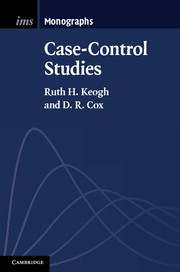Book contents
- Frontmatter
- Contents
- Preface
- Preamble
- Notes
- 1 Introduction to case-control studies
- 2 The simplest situation
- 3 Matched case-control studies
- 4 A general formulation
- 5 Case-control studies with more than two outcomes
- 6 Special sampling designs
- 7 Nested case-control studies
- 8 Case-subcohort studies
- 9 Misclassification and measurement error
- 10 Synthesis of studies
- Appendix: A theoretical diversion
- References
- Index
9 - Misclassification and measurement error
Published online by Cambridge University Press: 05 April 2014
- Frontmatter
- Contents
- Preface
- Preamble
- Notes
- 1 Introduction to case-control studies
- 2 The simplest situation
- 3 Matched case-control studies
- 4 A general formulation
- 5 Case-control studies with more than two outcomes
- 6 Special sampling designs
- 7 Nested case-control studies
- 8 Case-subcohort studies
- 9 Misclassification and measurement error
- 10 Synthesis of studies
- Appendix: A theoretical diversion
- References
- Index
Summary
The misclassification of exposures and outcomes and errors in continuous exposures result in biased estimates of associations between exposure and outcome. A particular consideration that arises in case-control studies is differential error or misclassification that depends on the outcome.
Relatively simple methods can be used to correct for misclassification in binary exposures, provided that there is information available on the sensitivity and specificity of the measured exposure, for example from a validation study. These methods extend to allow differential misclassification and additionally to allow for misclassification in binary outcomes.
Error in continuous exposures arises in many areas of application and can take different forms. The form of the error influences its effect on the estimated association between exposure and outcome.
A commonly used method for correcting error in continuous exposures is regression calibration, which relies on an assumption of non-differential error. Correction methods that allow differential error include multiple imputation and moment reconstruction.
Preliminaries
In this chapter we discuss the effects of misclassification and measurement error and methods for making corrections for these effects. The focus is naturally on case-control studies, but much of the discussion and methods apply more generally. After some preliminary remarks, the chapter is divided broadly into three sections:
• misclassification of a binary or categorical exposure;
• misclassification of case-control status;
• error in the measurement of a continuous exposure.
- Type
- Chapter
- Information
- Case-Control Studies , pp. 212 - 239Publisher: Cambridge University PressPrint publication year: 2014



